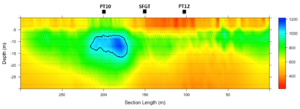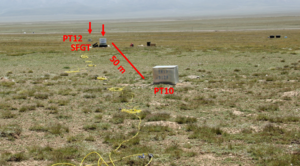Annualmeeting:2017 CSDMS meeting-120: Difference between revisions
Created page with "{{CSDMS meeting personal information template-2014 |CSDMS meeting first name=Bin |CSDMS meeting last name=Cao |CSDMS meeting institute=Lanzhou University |CSDMS meeting city=L..." |
No edit summary |
||
| Line 8: | Line 8: | ||
}} | }} | ||
{{CSDMS meeting scholar and pre-meeting | {{CSDMS meeting scholar and pre-meeting | ||
|CSDMS meeting pre-conference= | |CSDMS meeting pre-conference=Bootcamp | ||
|CSDMS meeting post-conference= | |CSDMS meeting post-conference=No | ||
}} | }} | ||
{{CSDMS meeting select clinics1 | {{CSDMS meeting select clinics1 | ||
| Line 26: | Line 26: | ||
|CSDMS meeting abstract submit=Yes | |CSDMS meeting abstract submit=Yes | ||
}} | }} | ||
{{CSDMS meeting abstract title temp}} | {{CSDMS meeting abstract title temp | ||
{{CSDMS meeting abstract template}} | |CSDMS meeting abstract title=Very Fine Scale of Permafrost Distribution and Controlling Factors | ||
}} | |||
{{CSDMS meeting authors template | |||
|CSDMS meeting coauthor first name abstract=Tingjun | |||
|CSDMS meeting coauthor last name abstract=Zhang | |||
|CSDMS meeting coauthor institute / Organization=Lanzhou University | |||
|CSDMS meeting coauthor town-city=Lanzhou | |||
|CSDMS meeting coauthor country=China | |||
|CSDMS meeting coauthor email address=tjzhang@lzu.edu.cn | |||
}} | |||
{{CSDMS meeting abstract template | |||
|CSDMS meeting abstract=Besides long-term monitoring in changes of thermal state of permafrost and active layer thickness, the knowledge of permafrost distribution at very fine scales (tens of meters) in discontinuous permafrost is still largely unknown in Qinghai-Tibet Plateau (QTP). A permafrost island was found by using geophysical investigations in the Heihe River Basin in northeastern QTP. Permafrost island was present at PT10 site beneath alpine steppe and coarse soil with a quality of gravel in surface soil (Fig. 1, Fig. 2). In contrast, permafrost is absent at SFGT site with density land cover area and relatively less gravel. The results showed that the ground surface temperature (5 cm) at PT10 site is lower in winter and higher in summer than the SFG site. The presence of permafrost is caused by soil conditions, especially by high thermal conductivity, based on field investigations. To address the controlling factors of permafrost presentences a 1D heat transfer model is used to compare the ground temperature difference between these two sites by only changing the soil conditions. | |||
}} | |||
{{CSDMS meeting abstract figures | |||
|CSDMS meeting abstract figure=ERT-based Permafrost Island.png | |||
|CSDMS meeting abstract figure caption=Fig. 1 ERT measurements conducted in 31/07/2015 with an electrode probe interval of 5 m. Permafrost island are roughly determined by the resistivity contour of 1010 Ω, which is the resistivity value at the interface of frozen/unfrozen. Borehole locations are marked by black square. | |||
}} | |||
{{CSDMS meeting abstract figures | |||
|CSDMS meeting abstract figure=Land Cover.png | |||
|CSDMS meeting abstract figure caption=Fig. 2 Photograph of land cover taken in 31/07/2015. | |||
}} | |||
{{blank line template}} | {{blank line template}} | ||
Revision as of 08:47, 30 March 2017
Browse abstracts
Very Fine Scale of Permafrost Distribution and Controlling Factors
[[Image:|300px|right|link=File:]]Besides long-term monitoring in changes of thermal state of permafrost and active layer thickness, the knowledge of permafrost distribution at very fine scales (tens of meters) in discontinuous permafrost is still largely unknown in Qinghai-Tibet Plateau (QTP). A permafrost island was found by using geophysical investigations in the Heihe River Basin in northeastern QTP. Permafrost island was present at PT10 site beneath alpine steppe and coarse soil with a quality of gravel in surface soil (Fig. 1, Fig. 2). In contrast, permafrost is absent at SFGT site with density land cover area and relatively less gravel. The results showed that the ground surface temperature (5 cm) at PT10 site is lower in winter and higher in summer than the SFG site. The presence of permafrost is caused by soil conditions, especially by high thermal conductivity, based on field investigations. To address the controlling factors of permafrost presentences a 1D heat transfer model is used to compare the ground temperature difference between these two sites by only changing the soil conditions.


